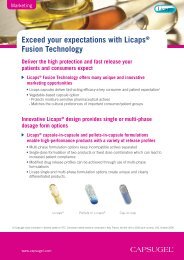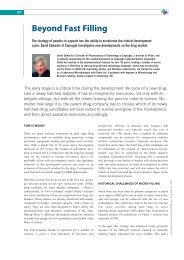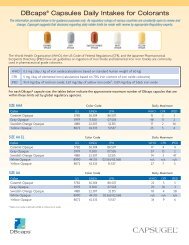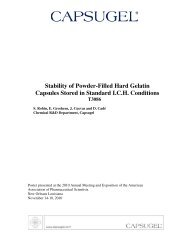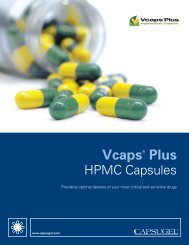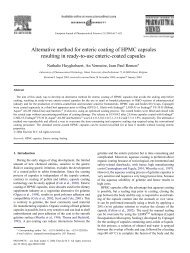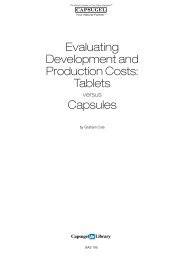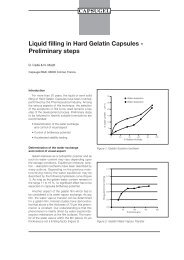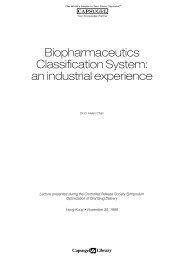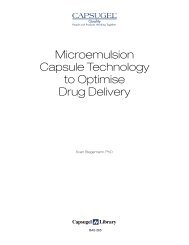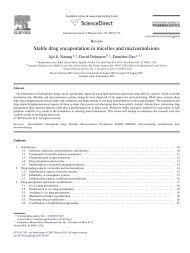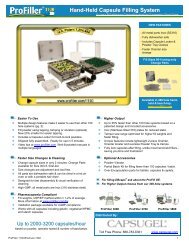Enteric coated hard gelatin capsules - Capsugel
Enteric coated hard gelatin capsules - Capsugel
Enteric coated hard gelatin capsules - Capsugel
Create successful ePaper yourself
Turn your PDF publications into a flip-book with our unique Google optimized e-Paper software.
<strong>Enteric</strong> <strong>coated</strong><strong>hard</strong> <strong>gelatin</strong> <strong>capsules</strong>Professor Karl THOMA and Karoline BECHTOLD
SummaryAbout the authorsDuring the early stages of pharmaceuticaldevelopment an enteric <strong>coated</strong> <strong>hard</strong> <strong>gelatin</strong>capsule is often the only possibility toadminister an acid labile drug or to protectthe stomach from a potentially irritant drugsubstance. These and other therapeuticapplications of enteric <strong>coated</strong> pharmaceuticaldosage forms have been reviewed.The properties of the various enteric filmforming agents are described along withplasticizers and other excipients and formulationswith each polymer system aresuggested.General difficulties of enteric coating dosageforms and those specific to <strong>hard</strong> <strong>gelatin</strong><strong>capsules</strong> are discussed as well as aspectsof product stability. The coatingprocesses most commonly used are described.Over 100 references have been sited.Karl Thoma is professor of pharmaceuticaltechnology at the University of Munich. Hegraduated as a pharmacist in 1955 andreceived his doctorate in pharmaceuticaltechnology in 1959. After lecturing at theUniversity of Munich he became professorof pharmaceutical technology in Frankfurtin 1967 and was director of the Institute ofPharmaceutical Technology from 1970 to1980 before returning to Munich. He is amember of the German PharmacopoeiaCommission and chairman of its PharmaceuticalTechnology Section and an alternatemember of the European PharmacopoeiaCommission. He is a member ofone of the Commission of Experts for theRegistration of New Drugs at the GermanDepartment of Health and Chairman of theScientific Council of the German Associationof Pharmacists. His research interestsare in the area of drug stability and newdosage form design and he is the authorof about 350 articles in scientific journalsand books.Karoline Bechtold is research assistant inthe department of Pharmaceutical Technologyat the University of Munich. Shegraduated as a pharmacist in 1988 fromthe University of Munich and continued asassistant to Prof. Thoma. Her research activitiesat present are in the area of the developmentand stability of enteric <strong>coated</strong>dosage forms.2
<strong>Enteric</strong> <strong>coated</strong><strong>hard</strong> <strong>gelatin</strong> <strong>capsules</strong>Prof. Karl Thoma and Karoline BechtoldDepartment of Pharmaceutical Technology, Ludwig Maximilian University, 8000 Munich 2, Germany.Table of contentsI. Therapeutic applications of enteric<strong>coated</strong> filmsII. Film componentsa. General composition and film coatingformulationsb. Survey of enteric <strong>coated</strong> film formersc. Characteristics of enteric <strong>coated</strong> film formersd. Plasticizerse. Anti-adhesion agents, pigments, colourantsf. Other additivesIII. Formulations for the enteric coatingof <strong>hard</strong> <strong>gelatin</strong> <strong>capsules</strong>IV. Technological aspects and problemsin enteric coating <strong>capsules</strong>a, General film coating problemsb. Special problems relating to <strong>capsules</strong>c. Stability of <strong>coated</strong> <strong>hard</strong> <strong>gelatin</strong> <strong>capsules</strong>V. Processes for coating <strong>hard</strong> <strong>gelatin</strong> <strong>capsules</strong>VI. ReferencesI. Therapeutic applicationsof enteric <strong>coated</strong> filmsField of applicationof enteric <strong>coated</strong> dosage forms<strong>Enteric</strong> <strong>coated</strong> dosage forms, such as <strong>coated</strong> tablets,sugar-<strong>coated</strong> tablets, soft and <strong>hard</strong> <strong>gelatin</strong><strong>capsules</strong>, granulates or pellets, have their firm placein the medical arsenal (1a, 2). An investigation of181 ready-to-use enteric <strong>coated</strong> medicaments revealedthat this sample comprised about 59 % sugar-<strong>coated</strong>tablets (106 preparations), about 27 %film-<strong>coated</strong> tablets (49 preparations) and about14 % soft and <strong>hard</strong> <strong>gelatin</strong> <strong>capsules</strong> (25 preparations)(1). However, this group of investigated preparationscovered only some of the preparations onthe German market.The preparations most commonly provided withenteric coatings contain pancreatin and other proteolyticenzymes, diclofenac, cardiac glycosides,electrolyte preparations with sodium, potassiumand magnesium salts as well as calcium, iron andmanganese preparations. Bisacodyl preparations,preparations containing valproic acid as well as formulationswith plant extracts or terpenes are alsocommon.Nowadays, enteric coatings are in particularused to:• protect active substances destroyed by theacidic gastric juice,• improve tolerability of medicaments irritatingthe stomach by only releasing them in the smallintestine,3
• making active substances available after a timedelay (sustained release),• achieving targeted release and concentration inthe small intestine.<strong>Enteric</strong> coating to stabiliseacid-sensitive medicamentsMedicaments which could be destroyed by gastricjuice include pancreatin and pancreatic lipase,which decompose at pH values of 4 and under. Inartificial gastric juice, lipase activity decreases toabout 10 % of the initial value within 15 minutes atpH 3.5. The majority of formulations containing pancreatinor other digestive enzymes are thereforeprocessed to make them resistant to gastric juice(3, 4, 7).In the case of enzyme preparations in particular,gastric-juice resistance often has to be associatedwith rapid degradation in the small intestine. Sincefood constituents are mainly absorbed in the duodenumor in the upper region of the jejunum (5, 6),where their enzymatic splitting must already havecommenced here after passage through the stomach.An enteric <strong>coated</strong> dosage form should thereforedegrade as quickly as possible in the small intestine.This is noticeably below the upper limitingvalue of degradation of not more than 60 minutesgiven in DAB 9.In the case of cardiac glycosides there have alsobeen reports of acid-associated hydrolysis and reductionin the efficacy of digitoxin has also beenclaimed (8, 11). In this case some findings do, however,dispute whether enteric coatings improve efficacy(9). Apart from digitoxin and digoxin, the possibilityof hydrolytic degradation has also beenreported in particular in connection with strophanthin(9) and proscillaridin (10), whereas the correspondingmethyl ethers such as meproscillaridin arethought to be more stable (11).With regard to antibiotics, penicillin G is known tobe unstable in the presence of gastric acid (15). Nowadays,enteric <strong>coated</strong> penicillin formulations have,however, been superseded by the synthesis ofstable penicillin derivatives.The activity of antibiotic formulations containingerythromycin is significantly improved by entericcoating (12, 13, 14). The hydrochloric acid in thestomach transforms erythromycin as well as erythromycinstearate into the hydrochloride, which is30 to 70 % less active (14). In this case erythromycinestolate, which is stable, could be used as analternative to enteric <strong>coated</strong> formulations.To improve stability, enteric coating is also recommendedfor bacterial preparations given whenthe intestinal flora is impaired (17). Other examplesof medicinal substances which need to be protectedagainst stomach acid are diethyl dithiocarbamate(18), the anti-tumour preparation N-ethylcarbamidomethylisoleucine(19) as well as tibenzoniumiodide (16), an antimicrobial benzodiazepine derivative.<strong>Enteric</strong> coating to improve toleranceSome active substances cause irritation of thegastric mucosa or are not tolerated for other reasonsfollowing their release in the stomach. Gastricdisorders have, for example, been reported inconnection with administration of diclofenac, phenylbutazone,oxyphenbutazone, salicylates, ironsalts, bisacodyl, valproic acid, indomethacin, potassiumchloride, tolbutamide, reserpine, nitrofurazone,anticoagulants, levodopa, ethionamide, thiazidesand diphenhydramine (28, 30, 54-74, 76, 77).Irritation of the gastric mucosa and gastrointestinalbleeding may occur after the peroral administrationof certain analgesics. Disturbances of this typeare, however, in part also connected with an influenceof prostaglandin synthesis related to a systemiceffect. Although it has been shown, forexample in the case of acetylsalicylic acid and itsderivatives, that side effects (20, 21, 24) are due toprostaglandin synthesis inhibition (23), some findingssuggest that gastric lesions are markedly reducedwhen enteric <strong>coated</strong> dosage forms are given(22, 26).Similarly, there is conflicting evidence in the caseof phenylbutazone and its derivatives as to whetheror not enteric coatings improve tolerance. Recentinvestigations suggest, however, that local toleranceof enteric <strong>coated</strong> phenylbutazone preparations ismarkedly superior to that of formulations which arenot enteric <strong>coated</strong> (27, 28). A study involving 103patients reacting to long-term phenylbutazone therapywith gastrointestinal disorders also yielded positivefindings (28). It showed that these patientstolerated an enteric <strong>coated</strong> phenylbutazone preparationfor six years without problems.<strong>Enteric</strong> coating is also recommended for substancessuch as diclofenac, indomethacin, flufenamicacid and azapropazone, because of gastric intolerance(23, 25). According to the literature,enteric <strong>coated</strong> naproxen is not only better tolerated,but also displays superior biological availability (29).Gastrointestinal disturbances, nausea and vomitingwhich may be associated with the ingestion of4
iron salts (35), magnesium salts (34), cobalt chloride(32), sodium fluoride (33) and cobalt chloride (31)also often make enteric coatings desirable for medicamentscontaining them. In the case of potassiumchloride, however, reports of irritation in the small intestineare more frequent in this connection (36).In the case of theophylline and its derivatives, enteric<strong>coated</strong> formulations are believed to achieve amarked reduction in irritation (37). Very pronouncedgastric side effects occur when valproic acid is ingested.Because of its liquid consistency, this anticonvulsantalso presents pharmaceutical formulationproblems and is generally processed in theform of enteric <strong>coated</strong> soft <strong>gelatin</strong> <strong>capsules</strong> (30). Inthe case of chloroquine phosphate (38), bisacodyl(41) and levodopa (39, 40) the desire, not only toprevent possible irritation, but also to achieve targetedrelease of the active substance or delayed activity,may necessitate enteric coating.<strong>Enteric</strong> coating to delay onset of actionTo a certain extent, enteric <strong>coated</strong> formulationspostpone onset of action via targeted release in theintestine (42, 43, 50, 52). Prolongation of effect is,for example, reported to occur with use of enteric<strong>coated</strong> and non-enteric <strong>coated</strong> granulates of antibioticssuch as amoxycillin or cephalexin (44, 45).Similarly, in the case of sugar-<strong>coated</strong> preparations,the active substance content in a core with an entericcoating can be released about two to threehours later than the initial dosage <strong>coated</strong> thereon(75).In some cases, delaying the onset of action isbelieved to improve the biological availability of medicaments.A longer duration of action and higherblood level values have, for example, been reportedfor enteric <strong>coated</strong> quinidine (48), theophylline (38),ephedrine (51), sodium fluoride (53) and enteric<strong>coated</strong> ergot alkaloids (49).<strong>Enteric</strong> coating for targeted releasein the small intestineTargeted release in the small intestine may beused to achieve higher local active substanceconcentrations. This may be desirable for laxativescontaining bisacodyl and for sulphonamides used totreat intestinal disorders (46). It d also described forpeppermint oil and terpene derivatives used in thetreatment of colitis (47). In the case of vermicides,an enteric coating achieves targeted release of theactive substance in the small intestine (41).Possibilities of enteric <strong>coated</strong> <strong>capsules</strong>in the product development phaseDuring the early stages of development of a newchemical entity availability of the active substance insufficient quantities to develop a tablet or pellet canbe a problem. In such cases on enteric <strong>coated</strong> capsuleis often the only possibility to administer anacid labile drug.<strong>Enteric</strong> coatings are thus used for numerous medicaments.Critical appraisal is needed in those cases inwhich there are conflicting views on their use.In principle and provided they display adequateresistance and disintegration properties, are pharmacokineticallyappropriate and meet stability requirements,coatings of this type display important potentialin:• ensuring biological availability,• controlling the effects of medicaments and,• avoiding side effects.II. Film componentsa. General compositionof film coating formulations*Generally speaking, formulations for enteric filmcoating contain the following main components:• enteric film formers,• plasticizers,• anti-adhesion agents,• colourants or pigments,• solubilizers or dispersion agents and• other additives.To these may be added viscosity-enhancing suspensionstabilizers designed to retard the sedimentationof undissolved excipients or dispersed filmformers.Other additives that may be mentioned includesurfactants used as wetting agents or to emulsify lipophilicplasticizers in aqueous formulations. Defoamingagents and hydrophobic substances are sometimesalso added to formulations.Whereas the majority of enteric <strong>coated</strong> films havehitherto been applied as solutions in organic solvents,there is a growing trend today to use neutralizedaqueous solutions or aqueous polymer dispersions.On the one hand, the aqueous base relieves(*) Data from the literature and the quoted film formulations are given without guarantee of correctness.5
the user of certain disadvantages and problems oforganic formulations such as (82):• costs of exhaust air disposal or recovery forenvironmental protection reasons,• removal of solvent residues in the film-<strong>coated</strong>product,• need for explosion protection,• protection of the workforce against the toxic effectsof solvents,• high cost of solvents,• storage of substantial amounts of inflammablesolvents.Additional regulations regarding organic solventscannot be ruled out.Aqueous dispersions have the advantage thatthey can be sprayed in a higher percentage sinceviscosity is virtually independent of molecularweight. The greater heat of evaporation of water ascompared to organic solvents can therefore be largelycompensated.On the other hand, transfer to aqueous systemsraises numerous individual questions requiring clarification,and difficulties have to be solved when developinga medicinal form. In many cases, aqueousdispersions or solutions may present instability problems.Reference is made in this connection to theremarks made under point 4.3.b. Survey of enteric film formersThe disadvantage of the former practice of <strong>hard</strong>ening<strong>hard</strong> <strong>gelatin</strong> <strong>capsules</strong> using formaldehyde,which brought about cross-linking of the <strong>gelatin</strong> andreduced gastric-juice solubility, is that post-<strong>hard</strong>eningprocesses take place during storage which cancause the <strong>capsules</strong> to become increasingly insoluble,in intestinal juice too, over the entire physiologicalpH range (82, 83, 95, 92, 93).Use of the following coating materials has largelybeen discontinued:- esters of organic acids, fats, waxes, fatty acids,resins such as salol, colophonium, carnauba wax,carnauba wax mixed with n-butyl stearate, beeswax,acetylated fatty acid glycerides; these substancesare decomposed by the digestive enzymesand the rise in pH in the intestine (88, 92, 93),- proteins such as keratin, zein and gluten; theseare resistant to pepsin in acid gastric juice, decompositionoccurs in the intestine through the action ofproteases (92, 93).The quality of natural substances such as shellacis liable to vary (81, 107).Shellac is also used mixed with other entericcoating polymers and to isolate sensitive cores(107).The film formers mainly in use today are polymerswith carboxyl groups, which are water insolublein the protonized state and pass into solutionin the weakly acid to neutral range between pH 5and 6,5 through formation of salts.Manufacturers of film polymers offer productsdisplaying a variety of release profiles since the releasecharacteristics can be directed in certainranges through the number of carboxyl groups andthe nature of the acids in the molecule (99). It is thereforepossible to choose a lower or higher dissolutionpH as required to influence the onset of degradationand release in the small intestine.Film formers may be subdivided into:• polymethacrylates:– methacrylic acid ethacrylate poly (MA 1 - EA 1),– methacrylic acid methyl methacrylate poly(MA 1 - IMMA 1) and poly (MA 1 - MMA2),• cellulose-based polymers:– cellulose acetate phthalate CAP,– cellulose acetate trimellitate CAT,– cellulose acetate succinate CAS,– hydroxypropylmethylcellulose phthalate HPMCP,– hydroxypropylmethylcellulose acetate succinateHPMCAS,• polyvinyl derivatives:– polyvinyl acetate phthalate PVAP,• other copolymers:– half esters of the copolymerisate of styrene andmaleic acid,– half esters of the copolymerisate of vinyl etherand maleic acid,– copolymerisate of vinyl acetate and crotonicacid.Their acid groups are either firm constituents ofthe molecular skeleton or are secondarily introducedthrough esterification of alcohol groups with diandpoly-basic acids such as phthalic acid, trimelliticacid or succinic acid. The principle of manufacturetherefore has consequences for the stability ofthe resultant films (sensitivity to hydrolysis).c. Characterization of enteric film formersPolymethacrylateTrade names:– for aqueous film coatingEudragit L 30 D (30 % aqueous dispersion),6
– for aqueous and organic film coatingEudragit L 100-55 (redispersable powder),Eudragit L 100 and S 100 (dry powder),– for organic film coatingEudragit L 12.5 and S 12.5 (12.5 % solutionsin isopropanol),Eudragit L 12.5 P and S 12.5 P (12.5 % solutionsin isopropanol with 1.25 % dibutyl phthalateas plasticizer).Manufacturer: Röhm Pharma, Weiterstadt, Germany.Solubility: Eudragit L from pH 6.0,Eudragit S from pH 7.0,Eudragit L 30 D / L 100-55 from pH 5.5.Eudragit L and S are copolymerisates based onmethacrylic acid and methyl methacrylate. The ratioof the free carboxyl groups to the esters is about1 : 1 for Eudragit L and ca. 1:2 for Eudragit S (101),resulting in enteric coatings with varying dissolutionpH values (L = easily soluble, S = sparingly soluble).Preferred solvents are isopropanol, acetone andethanol, as well as mixtures thereof. Delivery is eitherin isopropanolic solution with or without addedplasticizers or as solvent-free powder under thetrade name Eudragit L 100 or S 100 respectively.The latter product types can be dissolved in organicsolvents and mixtures or redispersed in water.Eudragit L 30 D and L 10-055: acrylic resins foruse in aqueous coating formulations consisting of acopolymerisate of methacrylic acid and ethyl acrylate,the carboxyl ester group ratio being 1 : 1.Eudragit L 10-055 is only the lyophilized adjunct toEudragit L 30 D dispersion (100). On partial neutralizationwith sodium hydroxide solution or organicbases the powder can be reprocessed into a redispersionlatex (degree of neutralization 3-6 %). Incontrast, Eudragit L 30 D only needs to be dilutedto appropriate concentrations.Since aqueous dispersions of Eudragit L 100or S 100 have high film-forming temperatures(> 85°C), mixing with the softer Eudragit L 30 D or L100-55 makes it possible to reduce the film-formingtemperature to < 40°C, thus reaching the conventionalprocessing range (100, 103). Mixing makes itpossible to achieve fine differentiation in the activesubstance release profile (pH 5.5-7.0), further modulationsin release profile can also be achieved bymixing in Eudragit NE 30 D (polyethylacrylate- methylmethacrylate)(99, 103).Organic Eudragit lacquers are often applied as 6to 10 % spray solutions (101), 10 to 20 % plasticizerbeing recommended. Suitable plasticizers are,for example, triacetin (91), PEG 6000 (81), dibutylphthalate (85) and diethyl phthalate (94).Aqueous Eudragit dispersions are processed inmore concentrated form, generally between 15 and30 % (101), although the upper concentration rangetends to be used for porous dosage forms. Itshould be noted with regard to the spectrum of excipientsthat there is incompatibility between EudragitL 30 D / L 100-55 and magnesium stearate(coagulation). The added plasticizer in these MA-EAdispersions should be at least 10 % based on thedry polymer substance content and may if necessary,be raised to 20-25 % without impairing thespecific solubility characteristics of the film (101). Itis possible to use various polyethylene glycols, citricacid esters (Citroflex ® ), triacetin, dibutyl phthalate,1,2-propylene glycol (101) and clibutyl sebacate(84). Eudragit acrylic resins have such a high pigmentbinding capacity that twice to three times theamount of pigments or other excipients can be addedrelative to the dry polymer substance (101).Reference: FDA Drug Master File for Eudragit,USP XXII / NF XVII "Methacrylic Acid Copolymer,Type A, B, C" ;Cellulose derivativesCellulose acetate phthalate– for aqueous film coating:Aquateric (FMC Corporation, USA),CAP as ammonium salt (Eastman Kodak, USA),– for organic film coatingCAP (Eastman Kodak, USA).Solubility: above pH 6.2-6.5.Aquateric: a dry powder that must be dispersedin water before use (redispersion latex). Otherconstituents apart from 63-70 % cellulose acetatephthalate (98) are polyoxypropylene-polyoxyethyleneblock copolymer and acetylated monoglyceridesintended to improve the physical stability andformulation of the product and necessary for technicalmanufacturing reasons.Suitable plasticizers: diethyl phthalate (98), triacetin(81). Triethyl citrate, on the other hand, is incompatiblewith Aquateric (82).CAP: suitable organic solvents are acetone (85,91), mixtures of acetone and ethanol (81, 83), ofisopropanol or ethanol and methylene chloride, orethyl acetate (81, 93, 95), of acetone and methylenechloride (90), of isopropanol methylene chloride water(81).Suitable plasticizers: triacetin 20-30 % related tothe polymer (81, 91), diethyl phthalate 25-60 %(111, 85), propylene glycol 133 % (90).7
Eastman Kodak also offers a possibility of usingCAP as a neutralized aqueous solution. The polymerpowder is not marketed in micronized form,with the result that it is not possible to preparea dispersion in water by analogy with Aqoat ®(HPMCAS). Instead, CAP is dissolved in a diluteammonia solution, the time to produce the clearspray solution depending on the amount of neutralizationagent, excess ammonia accelerating the dissolutionprocess. A disadvantage of this form of entericfilm coating is the presence of ammonium saltsin the dry film, causing the coat to be highly hydrophilized.In addition, the unpleasant smell of ammoniacauses problems during formulation.Reference: DAB 9, USP XXII-NF XVII, Drug MasterFile No. 8 (105).Cellullose acetate trimellitate– for organic and ammoniacal-aqueous film coating:CAT (Eastman Koeak, USA).Solubility: above pH 5.2.Since CAT already begins to pass into solution atph 5.2, the polymer is a necessary addition to CAP.What is more, the two film formers can be mixed inany ratio, making it possible to achieve a releaseprofile between CAT and CAP.Solvent: e.g. acetone-water, methylene chlorideethanol,acetone -ethanol, ethyl acetate-ethanol.Plasticizers: triacetin, acetylated fatty acid glycerides,diethyl phthalate.Reference: Drug Master File No. 6703, USFDA(105).Hydroxypropyimethylcellulose phthalate– for organic film coatingHP 50, HP 55, HP 55 S (Shin Etsu, Japan),– for aqueous film coatingHP 50 F and HP 55 F S (Shin Etsu, Japan,micronized powder),– HPMCP 50 and HPMCP 55 made by EastmanKodak may be applied as aqueous solution, bothin organic solution and neutralized with ammoniato yield an aqueous solution.Solubility: HPMCP 50 above pH 5.0,HPMCP 55 above pH 5.5.The two types of film former have different substitutionpatterns and hence different solubility profiles.HP-50 has a lower proportion of phthalic acid groups(21-27 %) than HP-55 (27-35 %) and therefore passesinto solution at lower pH values than its analog.Suitable plasticizers: PEG 400 to 6000 (80, 86),films containing the higher molecular weight PEGbeing mechanically more stable and less sticky, triacetin(81).Solvents: e.g. ethanol-water (79), acetone-water,acetone- isopropanol or ethanol (86, 81), ethyl acetate-ethanol,methylene chloride-ethanol (81), isopropanol-ethyleneglycol monoethyl ether-water(81).Reference DAB 9, USP XXII-NF X11 type 220824and 200731 (105).Hydroxypropyimethylcelluloseacetate succinateAqoat LF, MF, HF (Shin Etsu, Japan), micronizedpowder specially for the aqueous film coating usingdispersions.Solubility: HPMCAS LF above pH 5.0,HPMCAS MF above pH 5.5,HPMCAS HF above pH 7.0.The polymer is supplied in three types in eachcase with a different release profile determined bydifferent proportions of succinic acid,Suitable plasticizers: triethyl citrate, triacetin.Reference: Drug Master File No. 7507 (106).Carboxymethylethyl celluloseDuodcell (Freund ind. Co. Ltd.)Solubility: above pH 5.0.Carboxymethylethyl cellulose is manufactured byethylation of carboxymethyl cellulose and, incontrast to the cellulose derivatives describedabove, the hydroxyl groups of which have been partiallyreacted with di- or poly-basic acids, contain noester groups, but only ether groups. The mode ofmanufacture is intended to ensure an absence ofsensitivity to hydrolysis and special storage stability(110):CMEC may be dissolved to about 8 % in 70 %propanol, ethanol-water mixtures, methylene chlorideethanoland processed to ca. 8-12 % in water asredispersible powder (8 1, 110).Suitable plasticizers for organic or organicaqueoussolutions are myvacet 9-40, silicone oil, triacetin,diethyl phthalate, triethyl citrate and acety[tributyicitrate; glycerin monocaprylate being used foraqueous dispersions (Imwitor 908 R) (110),Reference: Standards for ingredients of drugsnot in the Japanese Pharmacopeia (110).8
Polyvinyl derivativesPolyvinyl acetate phthalateCoateric (Colorcon, UK).Opadry (Aqueous) <strong>Enteric</strong> (Colorcon, UK).Solubility: > pH 5.0.This enteric <strong>coated</strong> film former is characterizedby a low dissolution pH of 5.0.Suitable plasticizers for PVAP are diethyl phthalate,triethyl citrate (82), acetyltriethyl citrate, triacetin,PEG 400.Suitable solvents are ethanolacetone-water21:12 (83), methanol, methanolmethylene chloridemixtures.The dry commercial product Coateric is a filmconcentrate containing a suitable plasticizer in additionto the film former PVAP.Opadry (Aqueous) <strong>Enteric</strong> contains all formulationconstituents already premixed: film formers, plasticizers,anti-adhesion agents, pigments. The sprayformulation no longer needs to be reconstituted byadding water or solvent, a little ammonia solutionbeing added to aqueous dispersions to achievepartial neutralization. 15 parts by weight of Opadryare recommended for aqueous systems; 5 parts byweight for organic systems.Reference: USP XXII / NF XVII.Other copolymersCoating CE 5142 (BASF AG, Ludwigshafen)The copolymerisate of vinyl acetate and crotonicacid is converted into the salt with ammonia and isapplied as an aqueous solution (108). Since the hydrophilizedammonium salts do not decompose underthe conditions of spray application and drying,and the added amounts of ammonia are removed,the film has a marked tendency to swelling and softening,making it necessary to apply very high minimumthicknesses (107).As far as we know, the film polymer is no longercommercially available.d. PlasticizersPlasticizers are generally liquids or solids with ahigh boiling point which are intended to distributethemselves evenly in film polymers and improvetheir mechanical properties through interaction withthe polymer film.By using the appropriate plasticizer it is possibleto reduce the tendency of a film to become brittleand to increase its resilience. Spray formulationscontaining plasticizers often spread better over thesurface of the material and in the case of aqueousdispersions, addition of a plasticizer is generallyneeded to encourage film formation by means ofthermosetting or coalescence. Plasticizers increasethe motility of the polymer chains by interposingthemselves between the molecule chains and thusrestricting the ability of the film-forming chains to interactor bringing about conformative changes. Adynamic equilibrium is assumed (81) to developbetween plasticizer and polymer segments. Use ofa plasticizer reduces the glass transition temperatureTg.Because of its consistency, a <strong>coated</strong> <strong>gelatin</strong> capsuleis more susceptible to deformation, forexample when being removed from a blister pack,and slightly more plasticizer may be needed to preventdamage to the film.Plasticizers that have been named are (104):– alkyl esters of citric, tartaric and sebacic acids;examples: diethyl sebacate, triethyl citrate, tributylcitrate, acetyitriethyl citrate, acetyltributyl citrate,dibutyl tartrate,– esters of phthalic acid, such as dimethyl phthalate,diethyl phthalate, clibutyl phthalate, dioctylphthalate, ethylphthaloyl- and butylphthaloylethyl glycolate,– glycerol esters such as castor oil, sesame oil,acetylated fatty acid glycerides, glycerol diacetate,glycerol triacetate,– higher alcohols such as glycerol, 1,2-propyleneglycol,– polyethers such as polyethylene glycols and polyoxyethyiene-polyoxypropyleneblock copolymers;PEG also enhances gloss effects,– surfactants such as PEG-400 stearate, PEG sorbitanemonooleate, sorbitane monooleate.e. Anti-adhesion agents, pigments,colourantsAdhesion of coating substances during film coatinggives rise to unwanted aggregates. In addition,the freshly applied coats may be damaged in the attemptto separate the adhered parts. This effectmay be counteracted by anti-adhesion additives in9
the formulation or by applying the substances directlyinto the coating chamber. Useful separatingagents include talcum, magnesium stearate, Syloid ®(micronized amorphous silicic acid), Aerosil ® andkaolin.Film coatings can be coloured with titaniumdioxide and pigments (foodstuff colouring lakes, ironoxide pigments). Undissolved excipients should befinely distributed in appropriate dispersion agentsseparately from the film formers, preferably using aball mill, a toothed colloid mill or an Ultraturrax machineand only subsequently mixed with the remainingconstituents. When adding finely distributedpigments it is desirable to add additional nonionicemulsifiers, stabilizers, wetting agents such as PVP,Tween 60/80 and PEG, to the pigment suspensions(101). Spray suspensions generally need to be stirredduring the spray application. Many instructionsrecommend use of the smallest possible pigmentparticle sizes (< 15 µm) to obtain smooth films. Caremust be taken when adding pigments to ensurethat the upper limit for the particular film is not exceededsince the films increasingly lose their compactnessand resilience beyond this value.In the case of <strong>capsules</strong>, anti-adhesion agents oradded pigments may cause difficulties since theopaque coatings formed cause the originally oftenbrightly coloured and glossy <strong>gelatin</strong> <strong>capsules</strong> to becomematt. It is therefore advisable either to workwithout adding insoluble substances or else to selectpastel coloured <strong>hard</strong> <strong>gelatin</strong> <strong>capsules</strong> from theoutset.f. Other additivesSince aqueous dispersions can coagulate as areaction to foaming, foam can form in bubbles inthe finished film and pronounced foaming can impairprocessing, it is advisable, when using largebatches, to add an antifoaming agent, e.g. varioussilicon emulsions or sorbitan sesquioleate (109). Toprevent suspended pigments or polymer particlesseclimenting too quickly in the spray formulation itis possible to use suspension stabilizers such asPVP (in the form of Kollidon 25). Emulsifiers or wettingagents such as polyethylene glycol sorbitanfatty acid ester are added to formulations to moistenpigments or to distribute fat soluble substances(plasticizers, silicon oils) in aqueous sprayformulations.Ill. Formulations for the entericcoating of <strong>hard</strong> <strong>gelatin</strong> <strong>capsules</strong>The amount of polymer needed must be calculatedbefore starting the film coating process. In thecase of <strong>hard</strong> <strong>gelatin</strong> <strong>capsules</strong>, the surface area ofthe product to be <strong>coated</strong> is calculated (82, 101) andthe amount of coating required is then given in mgof dry polymer substance per cm 2 . The surfacemay either be calculated using the formula A = π x dx h (mm 2 ) or any of the available tables (84, 101):Capsule size 5 4 3 2 1 0 00 000Surfacearea mm 2 175 235 290 350 410 500 616 800There are five basic types of application system,each of which has quite specific properties.The film can be applied:• as an organic solution,• as an aqueous-organic coating emulsion,• as an aqueous alcoholic coating solution,• as an aqueous dispersion,• as a neutralized aqueous solution.In the case of neutralized aqueous solutions, theacids are only released from the salts of the filmpolymers under the influence of the gastric acid.Formulations for the film coating of <strong>hard</strong> <strong>gelatin</strong><strong>capsules</strong> quoted in the literature are set out belowto provide a summary of the practical application ofthe film formers presented. These formulationsshould only be regarded as indications and shouldbe adapted to the appropriate requirements andmodified to suit the product and process in eachindividual case.Eudragit filmsa. Organic solution of Eudragit L 100 (8 1)Constituents% parts by weightin finished formulationEudragit L 100 5.0Polyethylene glycol 6000(14 % based on the film former) 0.7Talcum 6.0Pigments 3.3lsopropanol 41.0Acetone 41.0Water 3.0Solid content of spray suspension: 15,0 %Content of dry polymer substance: 5.0 %Coating of dry polymer substance: 2-4 mg/cm 210
. Aqueous dispersion of Eudragit L 30 D (78)Constituents% parts by weightin finished formulationEudragit L 30 D 54.85Triethyl citrate(20 % based on the film former) 3.30Tween 80 as 33 % solution(i.e. 0.24 % surfactant in the formulation) 0.72Water 41.13Solid content of spray suspension: 20.0 %Content of dry polymer substance: 16.5 %Coating of dry polymer substance: 10.0 mg/cm 2 or 9.1 %Total dry substance coating: 12.1 mg/cm 2 or 11.1 %Coating machine: coating drum 35 em cliarn. with air atomization(1 mm bore)Machine loading: 1.5 kg size 0 <strong>capsules</strong>Drying temperature: 45°CProduct temperature: 27°CSpraying pressure: 0.8 barSrapying rate: 4.32 g/min/kgSpraying time: 128 minThe already pre<strong>coated</strong> <strong>capsules</strong> were sprayedwith this dispersion. The precoat was composed of46.51 parts Eudragit L 30 D, 4.65 parts glycerol(33 % related to the DPS), 4.65 parts Tween 80 (as33 % solution, i.e. the formulation contains 1.40 %surfactant) and 44.19 parts water. A precoat wasneeded to improve adhesion of the film to thesmooth surface of the capsule. 0.22 mg/cm 2 or0.20 % polymer or 0.32 mg/cm 2 or 0.29 % solidsubstance was applied. Alternatively it is possible touse an HPC precoat (78), applied as a 5 % solutionto obtain a coating of 4.0 to 6.0 mg dry polymersubstance per cm 2 (84).c. Aqueous dispersion of Eudragit L 100-55 (81)Constituents% parts by weightin finished formulationEudragit L 100-55 12.5PEG 6000 1.0Triethyl citrate(17.6 % based on the film former) 1.2Talcum 3.1Pigments 2.1Water 79.9NaOH 0.2Solid content of spray suspension: 20.1 %Content of dry polymer substance: 12.5 %Coating of dry polymer substance: 3-5 mg/cm 2Celluloseacetate phthalate filmsa. Organic CAP formulation (111)Constituents% parts by weightin finished formulationCellulose acetate phthalate 5.56Diethyl phthalate(60 % based on the film former) 3.34lsopropanol 22.78Methylene chloride 68.32Solid content of spray suspension: 8.9 %Content of dry polymer substance: 5.56 %Amount applied: 32.5 mg film per capsuleCoating machine: coating panProduct: size 2 <strong>capsules</strong>Using acetone as solvent, Jones (85) obtainedcapsule coatings of even smoothness. Applicationof 4-6 mg/cm 2 CAP, corresponding to 25 to 35 jumfilm thickness, a 5 % solution with 1.25 % diethylphthalate as plasticizer produced an enteric coatingof uniform appearance.b. Aqueous formulation of Aquateric (98)Constituents% parts by weightin finished formulationAquateric 10.66Diethyl phthalate 3.73Tween 80 0,32Water 85.29Solid content of spray suspension: 14.71 %Amount applied: 5.75 to 15 mg/cm 2 ,depending on fillerCoating machine: fluidized air bedSpray pressure: 1 barDrying temperature: 40°CCoating speed: 3.5 mI/minA precoat of 7.2 parts Eudragit RS 100 and 0.8parts dibutyl phthalate in methanol (0.4 mg/cm 2 )was needed to obtain gastric-juice resistance for<strong>hard</strong> <strong>gelatin</strong> <strong>capsules</strong> filled with sodium salicylatesince this active substance adjusts to a pH of 6 inthe diffusion layer and thus causes partial solubilityof the acid polymer.11
c. Low solvent content emulsion coating of HP-55 (87)Carboxymethylethyl cellulose filmsCoating of dry polymer substance: 8 mg/cm 2 Water 22.0Constituents% parts by weightAqueous formulation of Duodcell (81)in finished formulationConstituents% parts by weight HP-55 9.00in finished formulation Plasticizer (triacetin, PEG 6000,polyethylenegiycol-Duodcell 8.0400-monostearateTrisodium citrate 0.70or dibutyl phthalate) 1.50Tween 80 0.04Ethyl acetate 32.00Glycerol monocaprylate 2.40Sec-butanol 8.00Water 88.86Ethyl glycol 12.50Amount applied: 7 mg/cm 2Water 37.00Although emulsion coatings still contain solvent,Hydroxypropyimethyl cellulosephthalate filmsthey are no longer inflammable due to the amountof water present. The addition of water causes the<strong>gelatin</strong> to swell slightly when the formulation is applied' polymer penetrates the capsule shell and thea. Organic HPMCP solutions (79)Constituents% parts by weightfilm adheres well. Tendency to brittleness is alsocounteracted (87, 88).in finished formulationHP-55S 6.0d. Aqueous-alcoholic solutions of HP-55 (87)Triethyi citrate 0.9Constituents% parts by weightin finished formulationEthanol 79.1Water 14.0HP-55 9.00Plasticizer (see above) 1.50Coating machine: Aeromatic Strea-1Isopropanol 36.00with 1.2 mm jet diam.Ethyl glycol 17.50Loading: 250 g size 1 <strong>capsules</strong>Water 36.00Coating amount: 47 mg polymer per capsuleA clear film is formed since ethyl glycol, which(750 g spray soln.)has a high boiling point, is.a good solvent for theSpray pressure: 0.8 barfilm constituents (87).Drying air temperature: 36-38 OCProduct temperature: 31-33 'CCoating speed: 6.3 g/ minHydroxypropyl cellulose acetatesuccinate filmsThe gastric-juice resistance and appearance of<strong>capsules</strong> film <strong>coated</strong> in a laterally ventilated drumNo published formulations for the film coating of<strong>hard</strong> <strong>gelatin</strong> <strong>capsules</strong> were found.instead of in a fluidized air bed were inferior (somewhatcloudy, overlap between body and cap insufficientlycovered).b. Aqueous HPMCP dispersions (81)Polyvinyl acetate phthalate filmsa. Organic formulation of PVAP (81)Constituents% parts by weightConstituents% parts by weightin finished formulationin finished formulationHP-50F 10.0PVAP 11.0Triacetin 3.0PEG 400 1.0Water 87.0Ethanol 66.012
. Aqueous formulation using Opadry <strong>Enteric</strong> (81)Constituents% parts by weightin finished formulationOpadry <strong>Enteric</strong> 15.0Water 85.0Added ammoniaProtective coatingsA special problem when film coating <strong>capsules</strong>with organic polymer solutions is imperfect adhesionof the enteric coating onto the smooth surfaceof the capsule, the so-called orange peel effect.A precoat can be applied to prevent this. Forexample, a 5 % aqueous solution of HPC (Klucel EF,Hercules) or HPMC (Pharmacoat, Shin Etsu) is suitable(83,84) with a coating of 3 to 6 mg/cm 2 drypolymer substance. A solution of PVP or HPMC inan ethanol-mthylene chloride mixture has also beendescribed as a precoat (87) (coating 5 to 10 % ofthe total coating weight).The main difficulty with aqueous formulations isthat the <strong>gelatin</strong> shell softens. This can be preventedby applying an intermediate layer of gastric-juice solubleEudragit E in aqueous-alcoholic solution in anamount of about 10 % of the total coating (87).Since the film polymers presented are only insolublein water in the protonized state, basic capsulefill materials which form a diffusion layer with neutralto alkaline pH value may reduce gastric-juice resistance.Diffusion barriers in the form of precoatssuch as Eudragit RS should then be used (98).During storage of the film <strong>coated</strong> <strong>capsules</strong>, adhesionwhich sometimes occurs can be preventedby an overcoat also composed of HPC or HPMC(83.84). Use of an overcoat also improves the appearanceof the <strong>capsules</strong> and can have a positiveeffect on the stability of the product.IV. Technological aspects andproblems in enteric coating<strong>capsules</strong>a. General film coating problemsAqueous dispersions are to a greater or lesserextent sensitive to electrolytes, pH shifts, foam formation,higher temperatures and frost, the effects ofshearing force in high speed stirrers, partly also tothe presence of organic solvents and finely distributedpigments. Coagulation may then occur (101,102). Coagulated dispersions are not reclispersibleand can consequently not be used.In view of their sensitivity, ready-to-use aqueousEudragit dispersions should be processed within 1to 2 days. Cooling is necessary in the case of somedispersions, such as HPMCAS.Aggregates of polymer can block the spray jetsTo prevent this, aqueous dispersions are passedthrough a fine sieve before the coating is applied(0.1 - 0.25 mm mesh size).Dosage forms can stick together during film coating,thereby damaging films layers already applied.Very soft films have also been found to stick togetherduring storage. The addition of anti-adhesionagents can lead to a loss of desired film transparencyin the case of <strong>hard</strong> <strong>gelatin</strong> <strong>capsules</strong>.Spraying losses due to the spray drying of thepolymer have been observed in the case ofaqueous dispersions. The distance between the jetand the product should be carefully adjusted, suitableplasticizers should be selected and optimumprocess parameters (drying temperature, amount ofair, spraying pressure, spraying speed, batch loading,etc.) should be determined so that the sprayyield is acceptable.b. Special problems relating to <strong>capsules</strong>Problems occuring during the coating of <strong>capsules</strong>are generally due to the characteristics of thecapsule wall - <strong>gelatin</strong>. This is illustrated by the followinglist of problems and their remedies:• During coating with aqueous spray formulationsthe <strong>gelatin</strong> shell softens and becomessticky due to solubilization.Remedy: precoating.• The <strong>gelatin</strong> shell becomes brittle due to waterevaporation and drying, especially when coatingbegins.This may also occur during long term storage.The brittleness causes the <strong>capsules</strong> to losetheir mechanical stability and they break underslight pressure (87).Remedy: precoating.• Insufficient adhesion of the film with splinteringand peeling of the coat (orange peel effect), especiallywith organic spray formulations.13
The capsule shell is very smooth and gives littleanchorage (81, 86, 87, 88).The influence of moisture causes film coats andthe <strong>gelatin</strong> wall to swell to a varying extent,which also causes the coat to become detached.Remedy: higher plasticizer content (81), a precoatin the form of a two-layer film coating (PVP,HPMC, Eudragit E) or the use of an aqueous-alcoholicsolution or a hydrated coating emulsionwith low solvent content (81, 87). Addition ofPEG 400 or PEG 6000 should also improvecontact (86).• Increased cracking on handling the medicament.Remedy: a higher proportion of plasticizer makesfilms more ductile (90).• Separation of the capsule halves due to movementin the coating machine (85).Remedy: use of <strong>hard</strong> <strong>gelatin</strong> <strong>capsules</strong> having patentclosures or banding the <strong>capsules</strong>.• Problem zone: contact zone between upperand lower capsule parts (94),Remedy: to prevent any liquid penetrating thespace between the cap and body when sprayingbegins, 0.2 to 0.3 % Aerosil 200 may be addedto the spray formulation to achieve rapid filling ofthe intermediate space (95).More plasticizer and the choice of a suitable coatingmachine also improve coverage at the join(79). Cracks may form at the contact site.Another possibility to prevent such effects is toapply a <strong>gelatin</strong> band to the capsule at the pointof overlap between the cap and body.The stability of a moisture sensitive active filledinto the capsule can be affected by aqueouscoating.This also applies to the use of not totally anhydroussolvents (95). The <strong>hard</strong> <strong>gelatin</strong> capsuledoes not provide a complete barrier since thecontact point of the two halves of the capsuleand the thin <strong>gelatin</strong> film at the transition betweenthe cylindrical and the curved part of the capsulerepresent possible moisture penetration zones.Remedy: if this occurs, anhydrous solventsshould be used (95), at least for the sealing coating.• Loss of the desired glossy, attractive appearanceof the capsule due to a non transparentfilm.Remedy: no pigment with a matt effect shouldbe added if the bright capsule colour is to be retained.The uniformity of the film (81), choice ofplasticizer and solvent also determine the transparencyof the film coat (79).c. Stability of <strong>coated</strong><strong>hard</strong> <strong>gelatin</strong> <strong>capsules</strong>Regardless of which enteric <strong>coated</strong> dosage formis used, instability does occur when films are applied.Investigations involving 181 preparations, predominantlytablets, revealed a number of stabilityproblems depending on duration of storage, temperature,<strong>coated</strong> active substance and other factors(96, 97).Particularly in the case of <strong>hard</strong> <strong>gelatin</strong> <strong>capsules</strong>stability problems are encountered above all in entericcoats applied in the form of aqueous dispersionsystems. A report by Murthy** (82), who has publishedinvestigations in this field of aqueous coat->ings, showed that <strong>hard</strong> <strong>gelatin</strong> <strong>capsules</strong> <strong>coated</strong> withAquateric displayed noticeably slower release afterthree-months' storage at room temperature due toreaction of the <strong>gelatin</strong> coat with CAP or with its hydrolysisproducts phthalic acid and acetic acidwhich makes the <strong>gelatin</strong> insoluble.Delayed dissolution, which may be due tochanges in the polymer, has been reported for Coatericfilms 9 months after manufacture.Good stability was reported for Eudragit L 30 D.Film characteristics and release performance remainedconstant, even after somewhat more stringentstorage conditions. <strong>Enteric</strong> film formers with an esterstructure are liable to hydrolyse under the influenceof moisture; in the case of cellulose derivatives,HPMCAS is considered more stable thanHPMCP and this, in turn, more stable than CAT andCAP.A stability study (83) compared organically appliedfilms of polymethacrylic acid-methyl methacrylateEudragit L 100, polyvinyl acetate phthalate andcellulose acetate phthalate with films obtained fromaqueous dispersions of Eudragit L 30 D, Coatericand Aquateric. The authors used diethyl phthalateas plasticizer. Aqueous dispersions of Eudragit werenonetheless somewhat superior to organic polyacrylatesolutions whereas Aquateric only matchedup to organic CAP systems when an overcoat wasused. Capsules film-<strong>coated</strong> with Coateric displayedsigns of instability in the form of lost gastric-juice re-14
sistance. PVAP organic system coaJts needed aprotective coating to prevent adhesion of the product.In this context, reference is made to special investigatorymethods for testing acid permeability(88) or release kinetics in vivo (89).V. Processes for coating <strong>hard</strong><strong>gelatin</strong> <strong>capsules</strong>Developments in machinery over the last fewyears in the field of coating methods have led to furtherrefinements, which are described briefy below:Dipping processes, used only occasionallyand on a small scale or in formulations made up bypharmacists (80, 86, 91), call for rather moreviscous dipping media. Using tweezers or capsulehalves fixed to a rotating plexiglass disc (91), eachcapsule half is dipped into the film solution. Theprocess is repeated until the layer has the desiredthickness.Use of horizontal drumsThe Acela Cota (Manesty Machines Limited, UK)is an example of a machine with a perforated drum.It works on the principle of a horizontally mounted,rotating cylinder to which drying air is fed through alateral lymounted shoe and then withdrawn fromanother location after passing through the bed ofproduct to be <strong>coated</strong>. The spray device is inside thedrum and sprays the rotating <strong>capsules</strong> from above.The Diacoater, Hi-Coater and Glatt-Coater are similarmachines of this type.Use of fluidized air bed processesIn fluidized air bed processes, air flowing througha screen in the base of the equipment keeps thematerial moving and is then sprayed with the filmformulation either in a counterflow principle fromabove (top spraying) or in a parallel flow principlefrom below.Movement of the material can be controlled moreaccurately by use of guide cylinders (Wurster inserts).The <strong>capsules</strong> are propelled upwards in an almostlaminar flow through the central guide tube bya powerful air flow, sprayed with the coating formulationand simultaneously dried by the stream of air.On discharge from the tube, the material flows freelydownwards outside of the cylinder towards thescreen in the base the equipment under gravityagainst a less powerful air flow and passes backinto circulation.Examples of this type of machine include Strea-1(laboratory model) and Aerocoater (Niro, Bubendorf,Switzerland) optionally with Wurster insert and Uni-Glatt (laboratory model) and Glatt-WSG (Glatt, Binzen,Germany) also optionally with Wurster insert.More recent combined processesIn the drum process the material is mainly movedby rotation of the container and in the fluidized airbed process it is moved by the stream of air. Combinationof both principles yields new possibilities ofhandling the material and optimizing the stream ofair as a means of drying. In this combined processthe stream of drying air does not have to move thematerial on its own and consequently less air isneeded. The interaction of centrifugal force, streamof air and gravitation causes circular movement ofthe material.A report by Osterwald on the coating of <strong>gelatin</strong><strong>capsules</strong> (87) compared the Driacoater, Wurster-WSG and Rotor-WSG with respect to HPMCP-55film coatings. It was found on the basis of the processparameters that the fluidized air bed permitteda larger batch volume but needed more energy becauseof the larger amount of inlet and exhaust air.There was, however, a comparative saving inenergy due to the rotor technology which optimizesthe air input.Application of HP-55 emulsion in classic fluidizedair bed processing in the WSG produced relativelyrough coatings since drying occurred very quickly inthe strong flow of air, moreover the spraying losseswere higher than when other machines were used.The rotor model produced a comparatively fasterfilm coating: <strong>capsules</strong> film-<strong>coated</strong> in this mannerwith an aqueous- alcoh oli c HP-55 formulationquickly became gastric-juice resistant and hadglossy, transparent coats.Other exarnples of more recent combined processesare the Roto-Processor (Niro, Bubendorf,Switzerland), the Ultracoater (also Niro) and the CF-Granulator (Freund Industrial Co. Ltd., Japan).Finally, a machine of a different type is the HüttlinKugelcoater(Hüttlin Entwicklung und Verfahrenstechnik,Steinen).Practical trials are needed in each individual caseto determine the best coating equipment and bestfilm coating formulation.15
VI. References1a. K Thoma, R. Oschmann and H. Heckenmüller; Dtsch. Apoth.Ztg. 126:1071 (1986).1. K. Thoma, R, Oschmann; Publication in preparation.2. W.G. Chambliss; Pharm. Technol. 7:124 (1983).3. G. Cordes; Pharm. Ind. 31: 328 (1969).4. H. Möller; Pharm, Ztg. 125: 2254 (1980).5. K.H. Grötzinger, A. Volkwein, R. Böhler; Arzneim. Forschung22: 1152(1972)6. L. Ehr<strong>hard</strong>t, V. Hartmann, L. Patt; Med. Welt 24: 45 (1973).7. L. Ehr<strong>hard</strong>t; Acta Pharm. Technol. Suppl. 1: 125 (1976).8. U. Peters, C. Funcke, T.U. Hausmann, W. Staib; Arzneim.Forsch. 28: 750 (1978).9. K. Lingner, W. Küssner; Arzneim. Forsch. 12: 835 (1962).10. K.E. Andersson, A. Bestler, A. Redfoss; Eur. J. Clin. Pharmacol.8: 135(1975).11. H. Einig, D. Mayer; Arzneim. Forsch. 28: 527 (1978).12. D. Clayton, A. Leslie; J. Int. Med. Res, 9: 470 (1981).13. T. Hovi, K. Josefsson, O.V. Renkonen; Eur. J. Clin. Pharmacol.25: 271 (1983).14. B.G. Boggiano, M. Gleeson; J. pharm. Sci. 65: 497 (1970).15. Z. Zalkrzewski, E. Siedlecka, E. Kozial; Fam. Pol. 35: 7 (1979).16. F. Fontani, G. Targa, D. Norde; Estr. Boll. Chim. Farm. 116: 705(1977).17. Gumma, AA Mirimanoff; Pharm. Acta Helv. 46: 278 (1971).18. B.K. Evans, V.G. Fenton-May, M.G. Lee; J. Clin. Pharm. 4: 173(1979).19. Ajinornoto, Co. Inc.; Jpn, Pat. Jpn. Kokai Tokkyo Koho 81, 65,823 (1981).20. C. Bogentoft; Eur. J. Clin. Pharmacol, 14: 351 (1978).21. A. Bennett, T. Clark-Wibberley, I.F. Stanford, J.E. Wright;J. Pharm. Pharmacol, 32:151 (1980).22. P. Lechat, P. Ganter, MA Fontagne, B. Flouvart; Thérapie22: 403 (1967).23. K.D. Rainsford, B.M. Peskar, K. Brune; J. Pharm. Pharmacol.33, 127(1981).24. J. Brandslund, H. Rask, N.A. Klitgaard; Scand. J. Rheumatol.8: 209(1979).25. F.L. Lanza, E.R. Umbenhauer, R.S. Nelson, M.F. Rack;J. Rheumatol. 9: 415 (1982).26. G.R. Silvoso, KA lvey; Ann. Intern. Med. 91: 517 (1979).27. V.A. John, Goldsborough; Biopharm. Drug Dis, 3: 67 (1982).28. N. Cardoe, P.D. Fowler; J. Int. Med. Res. 5: 59 (1977).29. 0.N. Gamst, A.K. Haga, T. Holler, A.H. Farup; Nov. Pharm. Acta46:1 (1984).30. W. Oelkers, G. Stoffels, H, Schäfer, H. Rieth; Arzneim. Forsch.27: 1088 (1977),31. M. Payne; Pharm. J. 25: 657 (1966).32. G. Smith, P.H. Cox; Pharm. J., 22: 245 (1963).33. M. Jacob, C. Duru, A. Puech; Sci, Tech. Pharma. 8: 93 (1979).34. A Warren, W. H. Davis; Swiss Patent 620,124 (1980).35. B. Helwig; Moderne Arzneimittel, Wissenschaftliche VerlagsgesellschaftmbH, Stuttgart (1980).36. H. Renker, E. Schaub, M, Bürgin; Arzneim. Forsch. 27: 845(1977).37. R.A. Upton, J.R. Powell, Th. W, Guenthert, J.F. Thiercelin;J. Pharmakokin. Biopharm. 8:151 (1980).38. O.A. Gubara, A.S. Geneidi, M.S. Adel; Pharm. Ind. 42: 947(1980).39. Laboratories Sobio Sa; French. Pat, Fr. Demancle 2, 116, 156(1970).40. K. Nishimura, K Sasahara, M. Arai, T. Nitanai; J. pharm.Sci. 73: 942(1984).41. G. Rothgang; Dtsch. Apoth. Ztg. 115: 701 (1975).42. B., Hänselmann, R. Voigt; Pharmazie 26: 57 (1971).43. J. Sjögren, C. Bogentoft; Alfred Benzon Symposium 17, Kopenhagen(198 1).44. H. Kato, H. Maekawa, Y, Tagagishi; US-Pat. 4, 250, 166(1977).45. Y. Miyauchi; Jpn. Pat. Jpn. Kokai Tokkyo Koho 79, 129, 115(1979),46. H.J. Pienaszelk, D.E. Resetarits, W.K Wilferth, H. Blumenthal;J. Clin. Pharmacol. 19: 39 (1979).47. J. Rhodes, B.K. Evans; Eur, Pat. Appl. 15: 334 (1980).48. C.M. Bakke, L. Anderud, A. Aslaksen; Acta Med. Scand. 207:183 (1980).49. J. Franz, L. Patt; US-Pat. 4, 411, 882 (1983).50. M.M. Ghorab; Bull. Fac. Pharm. Cairo Univ. 11: 259 (1972).51. J. Spitael, R. Kinget; Pharm. Acta Helv. 52: 106 (1977).52. D. Steinbach, H. Möller; Pharm. Ztg. 122: 507 (1977).53. M. Lorent, J.P. Gervois, J. Sondagh; J. Pharm. Belg. 34: 272(1979).54. German Association of Pharm. Industry, Red List (1982).55. U.E. Mutter, et al.; Pharm. Incl. 35: 815 (1973).56. D. Katz, J. Siegel; Progress in Gastroenterology, New York(1968).57. J.R. Hoon; Incl. Med. 38: 362 (1969).58. U.M. Smith, R.R. Babb; Fortschr. Med. 87: 1153 (1969).59. B. Arvidson, A. Magnussen, L. Soelvell; Läkartidnigen 74:4101 (1977).60. G.B. Howe, et al.; Aust. N, Z. J. Mod. 7: 600 (1977).61. V. Laine; Sven. Läkartidn, 65: 3838 (1968).62 J.E. Rossouw, M. Clark, M. Davis, R. Williams; Rheumatol.Rehabil. 15: 31 (1976).63. D. Birnbaum, D. Kormeli; Isr. Pharm. J. 18: 216 (1975).64. J.R. Leon<strong>hard</strong>s, G. Levy; J. Am. Med. Assoc. 193: 99 (1965).65. R. Clark, L. Lasagua; Clin. Pharmacol. Ther. 6: 568 (1965).66. G. Levy; Clin. Pharmacol. Ther. 8: 887 (1967).67. W.A. Rushford, P.D. Fowler; J. Int. Med. Res. 5, suppl. 2, 67(1977).68. E.H. Mauracher; Praxis 64: 1644 (1975).69. DA. Dropplemann; US Pal. 3, 993, 767.70. E. Schmid; Schweiz. Med. Wochenschr. 95: 1204 (1965).71. J.A. Beirne; Clin. Pharmacol. Ther. 16: 821 (1975).72. Anonymus; Drugs and Therapeutics Bulletin 10: 9 (1972).73. 0. Lockard, et al.; Gastrointest. Endosc. 26: 5 (1980),74. W. Rothe, G. Groppenbächer Pharm. Ind. 35: 723 (1973).75. B. Hänselmann; Pharmazie 26: 57 (1971).76. J.P. Deporte; J. Pharm. Belg. 31: 341 (1976),77. J.P. Deporte; J. Pharm. Belg. 31: 263 (1976).78. Röhm Pharma, Applicationsheet Eudragit L 30 D, 3191.79. Shin Etsu, Technical Information, 10/1988.80. Shin Etsu, Technical Information H-1 4 (1977).81. K.H. Bauer, K. Lohmann; H.P. Osterwald, G. Rothgang, ÜberzogeneArzneiformen, Wissenschaftliche VerlagsgesellschaftStuttgart (1988).82. K.S. Murthy, N.A. Enders, M. Mahjour, M.B. Fawzi; Pharm.Technol. 10: 36 (1986).83. K.S. Murthy, D.A. Kulbert, M.B. Fawzi; Journal of Biomat. Appl.3: 52 (1988).84. K.S. Murthy; Application-letter.85. B.E. Jones; Manuf. Chem. Aerosol News 53 (1970).86. K. Thoma; Neuere Arzneiformen in der Apolhekenrezeplur,Schriftenreihe der Bayer. Landesapothekerkammer Heft34 (1986).87. H.P. Osterwald; Acta Pharm. Technol. 28: 329 (1982).88. K. Thoma, R. Oschmann; Pharmazie 46: 278 (1991).89. K. Thoma, R. Oschmann; Pharmazie 46: 331 (1991).90. D. Werchan; Pharmazie 39: 275 (1984).16
91. J.P. Remon, P. Gyselinck, R. van Severen, P. Braeckman; ActaPharm. Technol. 29: 25 (1983).92. J.M. Aiache, S. Aiache, A. Jeanneret, F. Cornat; Boil. Chim.Farm. 114: 636 (1975).93. J.H. Aiache, J1. Vidal, S. Aiache, A. Jeanneret, F. Cornat;Labo-Pharma 232: 457 (1974).94. C. Boymond, J. Chanliau, R. Minck, A. Stamm; Pharm. Act.Heiv. 58: 266 (1983).95. F. Dussauge: Journées Galéniques de Saint-Rémy-de-Provence,Sept. 1989, 39.96. K. Thoma, H. Heckenmüller, R. Oschmann; Pharmazie 42: 832(1987).97. K. Thoma, H. Heckenmüller, Pharmazie 42: 837 (1987).98. 1. Cherette, J.A. Plaizier-Vercammen, Congr. Int. Pharm. Technol.5th, 478 (1989).99. K. Lehmann, D. Dreher, H. Götz, EP 0152038 B1 (1989).100. K. Lehmann, D. Dreher; Pharm. Ind. 48: 1182 (1986).101. Röhm Pharma, Info V-7, 1990Röhm Pharma, Info V-6Röhm Pharma, Info Eudragit L 30 DAnwendung in der Arzneirnittelherstellung Röhm Pharma,Info L/S-7 und 7a.102. Handbook of Pharmaceutical Excipients, Joint Publication ofthe Amer. Pharmaceutical Association and the Royal PharmaceuticalSociety of GB (1986).103. K. Lehmann; Acta Pharm. Technol, 31: 96 (1985).104. K. Thoma, H. Heckenmüller; Pharmazie 41: 328 (1986).105. Product information Eastman Kodak, Publication No. EFC-202, April 1991.106. Information from Syntapharm GmBH (Distribution of Aqoat inGermany by this Company), May 1990.107. R. Oschmann; Dissertation Munich (1985).108. K.H. Bauer, H. Osterwald: Pharm. Ind. 41: 1203 (1979).109. Product information from Shin Etsu Chemical Co.; "Shin-EtsuAqoat, for aqueous enteric coating and aqueous sustainedreleasecoating".110. Product information PK 7 4093 and PK-7 4200 Lehmann &Voss & Co, Hamburg.111. Correspondence from <strong>Capsugel</strong> (1990).17BAS 145 E 2000




